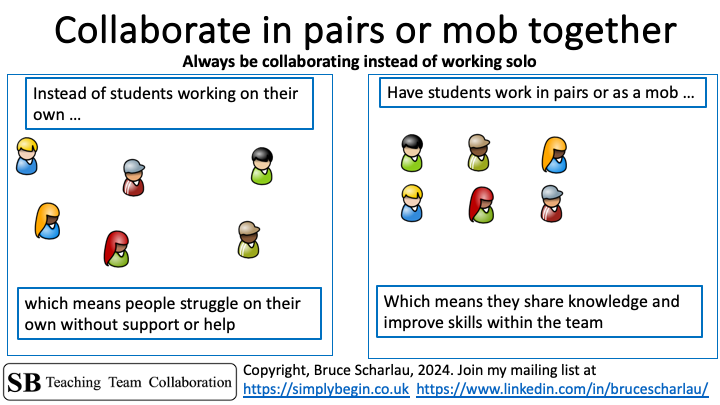The work is easier when shared with others than done on your own.
I find it frustrating when you can see a team could be working more collaboratively, but don’t. Most of the team members are fine with how they’re doing the work. When students are used to doing work individually, then they don’t see benefits for them to change how they work. For them, this makes no sense. Our job is to make collaborative work a ‘sensible’ option.
Students think it is ok to work individually, when pairing or mobbing would serve the team better. They use the habits that got them to where they are now. They don’t realise that as students, they should be learning and experimenting with different ways of working. The payoff for experimenting will help them later.
Students sometimes worry about their contribution in the collaboration. Even when they know the assessment is based on the ‘story of the collaboration’ they fear a low mark if they don’t develop ‘enough’ of the application. This is fine for some students, who are comfortable working on their own, and finding solutions independently.

Mobbing and pairing help students
Students who struggle to learn new things find the solo approach harder. These students spend more time doing the work. They feel more frustration. They might also have personal issues with their team members, who don’t appreciate the struggle they face. These struggling students would benefit from more pairing and mobbing as this would provide an opportunity to watch, ask questions, and practice what they learn.
The independent students think there is nothing in pairing and mobbing for them. They think the struggling students will only watch and ‘coast’. They miss the point of sharing what they know and that by guiding, explaining, helping the other students, they reinforce what they know to themselves too. Make them realise that they can be humble and learn too.
Help your student teams
I think there are a few things we can do in our classrooms to make collaboration more likely in our team projects.
First, provide classroom opportunities in previous classes to practice pairing so it happens before the larger team projects. This should take part from first year courses at the same time as students are learning to use version control.
Second, make it clear that pairing and mobbing are as much about sharing how to do something, as it is with code review/improvement. Code improvement is good, but so too is building shared understanding of what the team is building, and how.
Third, as I write this I wonder if there is an opportunity here for another assessment to break up the team project. I already have my teams write a report on a technology that they might use in their application. Perhaps, a smaller ‘pairing’ review would help reinforce the different perspectives on why people pair, and how it helps both people whether its senior:senior, senior:junior, or junior:junior in the pair. Students could do this after several pairing sessions with two or three different team members. I’ll have to discuss this with some people.
In any case, talk about this with your fellow staff members to find what they have found works, sort of works, or led to unexpected results. Do feel free to get in touch with me too if you want to share ideas.
This post is part of a project pulling together my materials and ideas about Teaching Team Collaboration: the Human-Side of Software Development for software development to students.
If you’d like to be notified of future posts, then please sign up for more using the adjacent form. When you sign up, then I’ll send you a free copy of the collaboration rules as a PDF from the book. You can also follow me on LinkedIn
The ideas above are from my book 101+ Ideas to Improve Team Collaboration, which covers all of these little things that students can do to improve their collaboration.